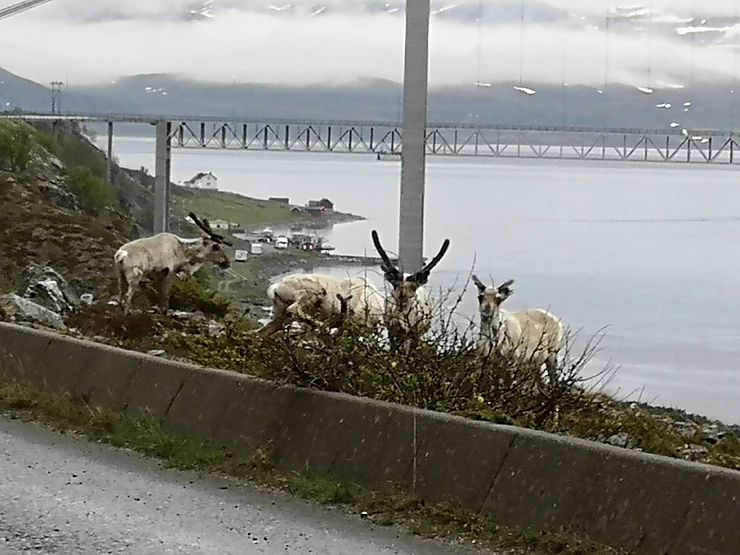By Karin Buhmann, Sanne Vammen Larsen and Anna-Sofie Hurup Skjervedal. This article is based on their previously written piece for the Centre for Business and Development Studies.
Insights into the concerns or needs of communities or individuals who may be affected by planned or proposed private or public energy projects or infrastructure projects is important for those who will eventually decide whether the project will be approved to make an informed decision. Such insights can be gained through consultations carried out as part of assessments of the environmental or societal impacts of projects.
This begs the question: what is a good process for stakeholder engagement of local communities and citizens in impact assessment processes? This is a global issue that in recent years has come to be high on the agenda in countries from the Arctic to the Global South.
Consultations as part of impact assessments
Consultations allowing for stakeholder involvement in impact assessments are common in regard to private projects concerning the establishment of mines, windfarms, sun-power farms and dams for hydro-power. The same applies to public infrastructure projects such as airports, roads and ports, which are often necessary for the transport of the products to be gained from private projects.
Societal impacts of projects are typically assessed through social impact assessment (SIA), environmental impact assessment (EIR), or human rights impact assessment (HRIA), or combined approaches such as ESIA or ESHRIA. All aim at identifying and preventing or mitigating adverse impacts and advance positive impacts, of planned projects or extension of existing ones. It is customary and often mandatory for the impact assessment to involve local stakeholders who are or may become affected by the project.
This typically takes place through consultations, which may take a variety of forms to enable public participation in the identification of the impacts of the planned activities. Consultations are organized by authorities or the organization having applied for a permit to engage in the new activity. In addition to environmental impacts, impact assessments often include the project’s effects on a range of broader societal issues, such as health and safety in the local areas, employment, local business and sources of income generation, etc.
The Nordics and many other countries have introduced mandatory consultations of local communities. Some international development banks, e.g. the World Bank, have made certain loans conditional on impact assessments.
Uncertainty about consultations
Despite the great significance of consultations for stakeholder involvement, there is often uncertainty with local communities and other groups of affected stakeholders in regard to what exactly a consultation is, what it entails and what to expect of the process. Moreover, even when consultations have taken place it is not infrequent that affected communities are unhappy with the process or the extent to which authorities take their concerns or needs into account.
For example, Sami groups living in the High North have complained to authorities in Norway and Sweden because they are concerned that windfarms disrupt the grazing areas of their reindeer and, as a consequence, the traditional way of life of the Sami. Authorities and business enterprises can also be unsure about what constitutes the proper process or ‘best practice’ for consultations with affected stakeholder.

What is a consultation?
Consultations on project activities are carried out to provide an informed foundation for decisions to be made. In providing access to participation in decision-making on activities that will affect one’s life at the everyday level, consultations contribute to a form of very direct democracy and can be argued to be part of the human right to public participation.
Consultations provide citizens with an opportunity to ask questions and express their views on a project. But as is the case for other democratic processes, one does not have a claim to seeing one’s views winning out. This is an important aspect for the appreciation of what to expect of a consultation; how to engage in a consultation process; and the information that authorities, companies and consultants must or should provide when conducting consultations.
It is not infrequent that consultations are conducted by a company involved in the project. A good consultation process marked by sincere dialogue and appreciation of local concerns can build understanding and acceptance of the final design of the project. A process that does not live up to local stakeholders’ expectations of influence can lead to the opposite result.
Accordingly, it is important for involved companies as well as authorities to ensure that stakeholders are given the information necessary to understand and assess how the project may affect them, what their rights are and what they can expect of the consultation process.
Local stakeholders’ expectations and understandings
Our investigations have demonstrated that it is not infrequent for actually or potentially affected stakeholders in a local community to be uncertainty of what a consultation entails or what to expect of the process and result. Others have shown that frustration results when authorities do not seem to take views made during a consultation into consideration in their decisions.
During meetings in northern Scandinavia in June 2019, we met with several inhabitants in Sápmi, who expressed frustration with consultation processes. Sápmi is the cultural region traditionally inhabited by the Sami people, an indigenous people who traditionally live from reindeer herding and fishing. Grazing areas on which the Sami’s reindeer depend are adversely affected by the establishment of windmills and mines.
Sami communities are involved and asked for their views through consultations, but they also see authorities granting permits to put up windfarms and new mines on contravention of the contesting views and concerns presented by the Sami during consultations. Authorities in Norway have granted permission to open a new copper mine in Northern Norway despite the opposing views submitted by the Sami Parliament (Sametinget). The motivation to engage actively in future consultations easily gets reduced, even with those who are aware that a consultation does not equal a claim to one’s views to be granted when central authorities are seen to make decisions affronting local democracy.
Some of our other meetings have shown that when English is a working language or the common ’lingua franca’ in an area that does not have English as its main language, mistranslations may occur and lead to misunderstandings about the process and objectives. For example, the Danish term for consultation, ‘høring’, often gets translated into English as ‘hearing’. This may give unintended associations to the conflict-oriented type of ‘hearing’ that takes place in courtrooms and it’s objective of determinations leading to a winner and a looser, thereby disrupting the understanding of the consultation’s objectives of dialogue and developing workable solutions. Our fieldwork in Greenland and elsewhere offers several examples of this mistranslation.
Consultations and the corporate ’social license to operate’
Consultations can contribute to risks of adverse impacts being identified and addressed before they develop into actual problems because consultations offer opportunities for local stakeholders, including those who are actually or potentially directly affected by the proposed project or project idea to express their concerns.
Because of this consultations not only matter to the longer-term well-being of the local community, but also to relations to the organization that is behind the project giving rise to the consultation.
For example, a consultation concerning a proposed mine matters not only for local stakeholders who are concerned with the mine’s impact on grazing areas or the quality of water, but also for the perception of the company that wants to carry out the project, and for trust in authorities who will be granting the permit or prescribe changes and conditions.
Authorities often delegate the task to conduct a consultation to the company that applies for an exploration or exploitation permit. One the one hand, this may strengthen the consultation process because the company conducting the process knows the project very well and is able to reply to questions of a technical character. On the other hand, participation in the consultation and trust in the process may suffer if local stakeholders, who are worried about contamination or other harmful effects, suspect that the consultation may be influenced by the company’s interests.
‘Fox in the henhouse’
Allowing the company that applies for a permit for the project to conduct the consultation can appear like letting the fox into the hen house.
However, if performed well, the company will obtain a better appreciation of the project’s impacts and will be able to make relevant adaptions. Likewise, authorities often lack both the necessary technical knowledge and other resources to conduct consultations. Companies lack knowledge, for example in regard to local issues are expected to purchase relevant expertise through consultant advice. The company thereby invests in establishing the necessary informed knowledge foundations for the permit to be granted by authorities.
When companies are given the responsibility to conduct consultations that may affect the decisions to be made by authorities, it is important that they carry out a correct and good consultation process that allows local stakeholders to participate at times suitable to them. If a consultation takes place during normal working hours many local stakeholders may decide to stay away because participating would mean a loss of income.
Likewise, participation may be limited if the consultation takes place in a location that requires long transport. Consultations conducted in another language than the local one reduces the opportunity for local stakeholders to engage in a dialogue. Unless technical or health-related issues are explained in a manner that matches the prerequisites of local stakeholders, risks arise that they will not obtain an adequate understanding of the impacts of the project. This will increase risks of misunderstandings and that relevant questions remain unasked, or that relevant concerns are not voiced.

During field workshops in Southern Greenland in August 2018, we were given insights into a diversity of local experience of consultation processes and expectations. The point of departure for our meetings was a proposed mine in Kuannersuit (Kvanefjeld) by the town Narsaq. Greenland’s eight largest towns, Narsaq has a population of around 1,500 and is placed in an area with extensive sheep grazing and tourism based around ruins of the Norse settlers. The mine will produce diverse minerals and rare earth elements, with uranium as a by-product due to high uranium contents at this specific site.
Consultations have been conducted by the company. We met with several sheep-farmers and actors in the emergent tourism sector who expressed concern whether uranium dust from the mine would harm their business, income and human and animal health in the area. Several individuals were frustrated with the process of the consultation, such as meetings taking place at locations or times of the day or year that made it difficult for the sheep farmers to travel to the meetings and take part in them. Moreover, as the Sami noted above, several people in the Narsaq area were basically concerned that the authorities do not seem to take the concerns voiced into account. Several questioned whether the process is accordance with the ideals of a democratic society.
Ups and downs of consultations
When consultations work well they can contribute to a sense of common or including decision-making. Research shows that this underscores the acceptance of the resulting activity, related to what is sometimes referred to as the legitimacy of the activity.
When consultations do not work well they can have the opposite effect and undermine trust, not just in the specific project but also in the company or companies involved. This relates to what is sometimes referred to as the ‘social licence to operate’. The term ’social licence to operate’ relates to the risk of loss, that a company (or companies) run as a result of local protest or opposition to a project for which they have applied for a legal licence.
Even if a company has obtained a legal licence, for example, to undertake the exploration of minerals, local opposition may be present. There are indications that a weak social licence to operate is on the rise in Greenland, thereby affecting the local legitimacy of projects like the Kuannersuit mine in Narsaq (Bowles and MacPhail, 2019).
Greenland is a country based on the rule of law with strong institutions and regulation and traditionally a relatively high level of trust in authorities and their decisions. Observations that in such a society and despite formal requirements, there is lack of trust in consultations and arms-length between authorities and companies conducting the consultations, and that concerns voiced by local stakeholders during consultations are taken seriously and acted upon are severe indications that formal procedures are not sufficient for a good consultation process. Accordingly, it is important to understand what constitutes a good consultation process from the perspective of the individual stakeholder, even if there is still no claim to having one’s way in regard to the final decision.
References
Bowles, P & MacPhail, F (2019) Coming to the Surface: The Social Licence to Mine in Greenland. Paper submitted for international seminar ‘Problems and Perspectives of social responsibility in natural resources exploration, exploitation, and management’, Pskov State University, Pskov (Russia) 23-25 October 2019 (on file with lead author).
About the authors
Karin Buhmann is Professor at Copenhagen Business School, where she is charged with the emergent field of Business and Human Rights. Her research interests include what makes stakeholder engagement meaningful from the perspective of so-called affected stakeholders, such as communities, and the implications for companies and public organisations carrying out impact assessments.
Sanne Vammen Larsen is an expert in the field of environmental planning and impact assessment, with a focus on integration of climate change in Impact Assessment, local processes and social impacts, and dealing with risk and uncertainty. She is employed as an associate professor at The Danish Centre for Environmental Assessment at Aalborg University, Denmark.
Anna-Sofie Skjervedal is PhD from Ilisimatusarfik – the University of Greenland and Aalborg University, and special consultant in public participation within the Municipality of Sermersooq, Nuuk, Greenland. Anna-Sofie specializes in public participation within impact assessment processes in relation to extractive industry development in Greenland with a focus on meaningful youth engagement.
Photo by davide ragusa on Unsplash
